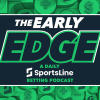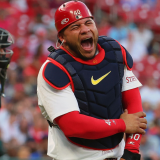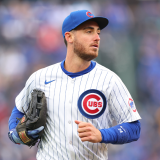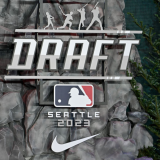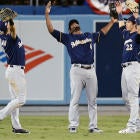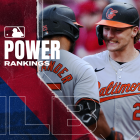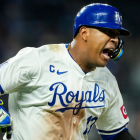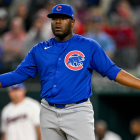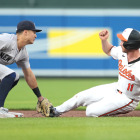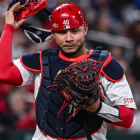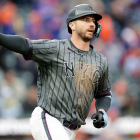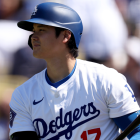If you want to see a model of how to handle a hot stove season, look no further than what the Brewers pulled off last winter.
With mega-revenue teams like the Yankees, Dodgers and Giants passing on big-money players in an effort to duck under the luxury-tax limit and clear the decks for aggressive bidding the following winter, Milwaukee swooped in. First, the Brewers pulled off a blockbuster deal with the Marlins, shipping four prospects to Miami for All-Star outfielder Christian Yelich. The next day, the Brew Crew consummated a five-year, $80 million contract with outfielder Lorenzo Cain, the third-priciest position player on the open market.
Those moves both proved to be grand slams. Cain was the best defensive center fielder in the majors, saving 20 more runs than the average player at his position. Meanwhile, Yelich went on a tear for the ages in September, turning a great season into a transcendent one by batting a gigantic .352/.500/.807 with 10 homers, propelling him to his first MVP award.
- 2018 Result: 96-67, first place in NL Central
- Key free agents: Mike Moustakas, Curtis Granderson, Gio Gonzalez, Wade Miley, Joakim Soria
- Needs: Starting pitching, second base, catcher
Led by Cain, the Brewers saved an incredible 116 more runs than league average, the second-best mark in all of baseball. Led by the league-leading Yelich, the Brewers finished second in the National League in home runs. Led by that dynamic duo, Milwaukee stormed to its first division title in seven years, coming up one game short of making just its second World Series in franchise history.
To make another deep October run next season, the Brewers don't need to land two MVP-caliber players per se. What they do need to do is beef up their pitching. Because expecting the same guys to deliver the kind of magical results the rotation and bullpen produced in 2018 is asking for trouble.
The Brewers finished a solid fourth in the NL in reliever ERA, but even that doesn't fully tell the story. Josh Hader emerged as one of the most devastating weapons at any position, doing an uncanny impression of Andrew Miller in his prime. In April against the Reds, Hader set an MLB record by striking out eight batters in 2 ⅔ innings. He cruised from there, anchoring a bullpen that by season's end was unhittable, with Hader sandwiched between fire-breathing right-handers Corey Knebel (who struggled so badly he went to the minors at one point, only to return and dominate in September) and first-time All-Star Jeremy Jeffress.
Hader, Knebel and Jeffress certainly have the skill to sustain their strong performance. The bigger concern is one of workload. We refer to Andrew Miller's prime in the past tense, since he's not the pitcher he was two years ago when Cleveland made its run to the World Series. It's hard not to link Miller's heavy usage that season in both the regular season and postseason to the injuries and diminished performance that have plagued him since then. So you can't help but wonder if the 91 ⅓ innings Hader threw last season -- almost all of them in high-leverage, high-stress situations -- might weigh on his numbers going forward. Same goes for Jeffress and Knebel, albeit to a slightly lesser extent.
The greater concern is the rotation. As much credit as the Brewers should get for scooping up Yelich and Cain, they were absolute wizards in finding discarded starters who made surprisingly big contributions in 2018 for the modern baseball equivalent of pennies. In January, they inked Jhoulys Chacin to a two-year, $15.5 million deal, then watched the lightly-regarded right-hander develop into the ace of the staff. They got Wade Miley on a one-year, $2.5 million deal on the eve of spring training, then saw him deliver a sparkling 2.57 ERA, with both journeymen flashing big moments in the playoffs to boot. Expecting monster returns from dollar-store acquisitions for the second year in a row is asking a lot.
The good news is that the Brewers have built the infrastructure to make another heady playoff run, even if the methods are different this time. It was that stellar defense that allowed soft tossers like Chacin and Miley to pitch to contact and actually succeed at it. The Crew can thus look toward another season of strong defense, but with better talent in case a few more balls land where they ain't.
Some potential additions include Nathan Eovaldi, one of the hardest-throwing starters in the game, author of one of the most memorable performances of the 2018 playoffs, and a pitcher who (unlike fellow free-agent pitchers like Patrick Corbin and Dallas Keuchel) doesn't have compensation attached to his signing. They're also pursuing righty Anibal Sanchez, who enjoyed an impressive comeback season in Atlanta. The most impactful pitching pickup could come from within, with 2017 ace Jimmy Nelson hoping to return from a shoulder injury that knocked him out for all of 2018.
The Brewers could also seek help at two up-the-middle positions. The catcher-needy Nationals' acquisition of veteran backstop Kurt Suzuki could make Yasmani Grandal a possibility for Milwaukee behind the plate. Meanwhile a potent veteran hitter like Daniel Murphy or Jed Lowrie could fit the bill at second base, if Brewers brass decides it's seen enough of the spectacularly erratic Jonathan Schoop to want to pay him something like $11 million in arbitration to give fans in the stands a cool breeze every time he comes to the plate.
Any and all of this would require digging a little deeper into the war chest. But Milwaukee's 2018 success, combined with some of the added revenue garnered during its postseason run, plus their current status as a team on the cusp of winning the pennant, could and should prompt owner Mark Attanasio to shoot his shot. A first-ever World Series win for the Brewers is a worthy goal to chase.
Jonah on the MLB offseason
NL East
Braves: May be offseason's most compelling team
Marlins: Finding where to send Realmuto
Mets: How Mets could jumpstart BVW era
Phillies: Harper or Machado might not be enough
Nationals: What will the Nats do if Harper leaves?
NL Central
Cubs: Keys to a Cubs rebound in 2019
Reds: Can Cincy revamp its pitching staff?



